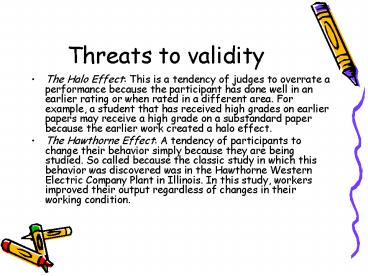Threats to validity PowerPoint PPT Presentation
Title: Threats to validity
1
Threats to validity
- The Halo Effect This is a tendency of judges to
overrate a performance because the participant
has done well in an earlier rating or when rated
in a different area. For example, a student that
has received high grades on earlier papers may
receive a high grade on a substandard paper
because the earlier work created a halo effect. - The Hawthorne Effect A tendency of participants
to change their behavior simply because they are
being studied. So called because the classic
study in which this behavior was discovered was
in the Hawthorne Western Electric Company Plant
in Illinois. In this study, workers improved
their output regardless of changes in their
working condition.
2
Threats to validity
- John Henry Effect A tendency of people in a
control group to take the experimental situation
as a challenge and exert more effort than they
otherwise would they try to beat the
experimental group. This negates the whole
purpose of a control group. So called because
this was discovered at the John Henry Company
where a new power tool was being tested to see if
it could improve productivity. The workers using
the old tool took it as a challenge to work
harder to show they were just as good and should
get the new tool.
3
Threats to validity
- Rosenthal Effect or Pygmalion Effect Changes in
participants behaviors brought about by
researcher expectations a self-fulfilling
prophecy. The term originally comes from Greek
mythology and was popularized by G.B. Shaw. Named
from a controversial study by Rosenthal and
Jackson in which teachers were told to expect
some of their students intelligence test scores
to increase. They did increase based solely on
the teachers expectations and perceptions. - Note A double-blind procedure is a means of
reducing bias in an experiment by ensuring that
both those who administer a treatment and those
who receive it do not know (are blinded to) which
study participants are in the control and
experimental groups.
PowerShow.com is a leading presentation sharing website. It has millions of presentations already uploaded and available with 1,000s more being uploaded by its users every day. Whatever your area of interest, here you’ll be able to find and view presentations you’ll love and possibly download. And, best of all, it is completely free and easy to use.
You might even have a presentation you’d like to share with others. If so, just upload it to PowerShow.com. We’ll convert it to an HTML5 slideshow that includes all the media types you’ve already added: audio, video, music, pictures, animations and transition effects. Then you can share it with your target audience as well as PowerShow.com’s millions of monthly visitors. And, again, it’s all free.
About the Developers
PowerShow.com is brought to you by CrystalGraphics, the award-winning developer and market-leading publisher of rich-media enhancement products for presentations. Our product offerings include millions of PowerPoint templates, diagrams, animated 3D characters and more.

